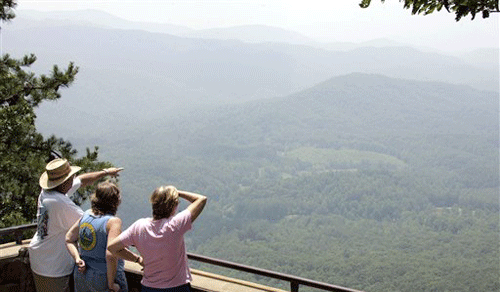Advertisement
Recovering the National Parks
Resume
In the heart of the Great Depression, thousands of unemployed Americans were put to work building the roads, trails, bridges and campgrounds of America’s national parks.
By the time our current economic crisis rolled around, many of those same facilities were in terrible shape — crumbling. And at the same time that cash-strapped American families are looking again to national parks for some affordable — and beautiful — recreation.
So, will the Obama stimulus billions rebuild the parks? This hour, On Point: We’re headed into America’s great national parks to check the trails and where they’re headed.
You can join the conversation. Tell us what you think — here on this page, on Twitter, and on Facebook.Guests:
Ron Tipton, senior vice president of policy for National Parks Conservation Association.
Roger Kennedy, director of the National Park Service from 1993 through 1997. He's the author of numerous books, including the forthcoming "When Art Worked: The New Deal, Art, and Democracy." From 1979 to 1992 he was director of the Smithsonian Institution's National Museum of American History.
Bill Wade, chair of the Executive Council for the Coalition of National Park Service Retirees. He lives in Tuscon, Arizona, and was reared in Mesa Verde National Park, in Colorado, where his father spent nearly his entire career as Chief Park Ranger. He began his National Park Service career in 1967, as a park ranger at Mount Rainier, Washington. He then worked at Yosemite, National Capital Parks, Grand Canyon, Great Smoky Mountains, Delaware Water Gap, Harpers Ferry, and finally as Superintendent of Shenandoah National Park.
More links:
The National Park Service website is a good source of information on the parks.
The Department of the Interior website details the projects in 107 national parks set to begin this summer, including a map. From the description:
Recovery Act efforts will begin in parks across America, from Lake Mead and Yellowstone, to Yosemite and the Grand Canyon. The National Park Service projects will preserve and protect national icons and historic landscapes, improve energy efficiency and renewable energy use, and remediate abandoned mines. These projects will fall under six basic types of activities: construction, deferred maintenance, energy efficient equipment replacement, trails, abandoned mines, and road maintenance. Examples of each are as follows:
Construction projects will build, rehabilitate, or replace facilities to help preserve natural and cultural resources and ensure safe, fun, and educational experiences for visitors.
Deferred Maintenance projects will repair, rehabilitate, or maintain critical facilities to extend their useful life. The NPS will undertake major repair and rehabilitation work and will complete maintenance to improve facility conditions.
Energy efficient equipment replacement efforts will replace aging vehicles, heavy equipment, and HVAC systems with next generation energy efficient equipment. By reducing its fossil fuel consumption, the NPS will reduce its carbon footprint and fuel costs.
Trails projects will complete work to restore trails for safer use and to extend the life of trails across the national park system.
The abandoned mine lands safety projects will remedy serious health and safety concerns at the sites. A consideration in choosing a particular remedy is the ability to provide continued use of the mine openings as wildlife habitat by maintaining access and airflow.
Road maintenance projects will preserve park roads and parkways and rehabilitate deteriorated road networks. The NPS is responsible for approximately 5,450 paved miles of public park roads, 6,544 miles of unpaved roads, the equivalent of 948 paved miles of parking areas, and 1,679 structures such as bridges, culverts, and tunnels.
This program aired on June 9, 2009.